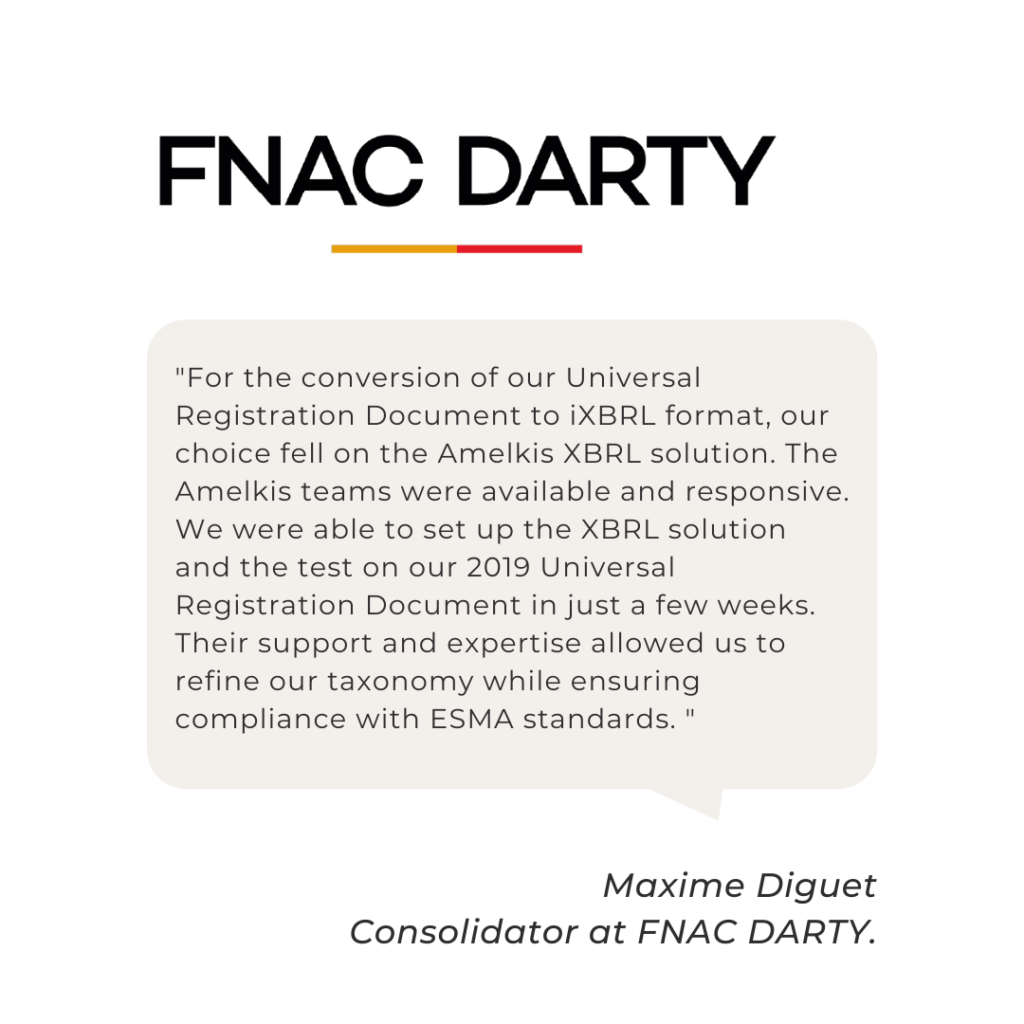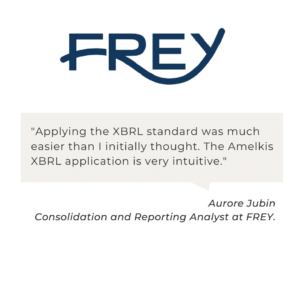XBRL FAQ

For your convenience, we collected the most asked questions regarding XBRL, and answer them in one overview. If your question is not (fully) answerd, please do not hestitate to reach out to us. We will gladly help you out.
What is XBRL?
XBRL is the open international standard for digital business reporting. The non-profit consortium, XBRL International, manages this standard. To start your XBRL reporting, you need XBRL software tools, such as Amelkis XBRL.
What does XBRL stand for?
XBRL stands for eXtensible Business Reporting Language.
Is XBRL mandatory?
Yes, if your company is listed and reports in IFRS and/or US GAAP.
Every country has its own set of national and international rules. EU-listed companies must comply with ESEF, while US-listed companies must abide by the laws of the SEC.
Curious about your company’s situation regarding XBRL? Do not hesitate to contact us: No question is too big or too small!
What is ESEF?
The ESEF is the electronic reporting format in which issuers on EU regulated markets prepare their annual financial reports from 1 January 2020. The ESEF Regulation requires that all issuers with securities listed on an EU regulated market prepare their annual financial reports in XHTML and mark-up the IFRS consolidated financial statements contained therein using XBRL tags and the iXBRL technology.
What does ESEF stand for?
ESEF stands for European Single Eletronic Format.
Is ESEF mandatory?
Yes, you must file in ESEF if your company is listed in the EU markets.
What are XBRL tags?
XBRL tags are labeled individual items of data. Examples of XBRL tags are ‚Net profit‘ and ‚Revenue.‘ Tags are always linked to taxonomies.
XBRL tagging aims to increase the transparency and accessibility of business information and financial reporting. Tagging is mandatory when you prepare your consolidated annual report using IFRS.
What are taxonomies?
XBRL taxonomies are reporting-area-specific hierarchical dictionaries. They define the specific tags for tagging, attributes, and interrelationships.
There are two types of taxonomy: Standard taxonomy and Extension taxonomy.
Standard taxonomies include the US GAAP Taxonomy and/or the IFRS taxonomy. This type of taxonomy acts as a template for filers to implement in their business reporting.
Extension taxonomies are created by the XBRL filer. If the existing taxonomy does not fully reflect your business, you can implement your own taxonomy. You do have to explain the reasoning behind your taxonomy. However, many companies around the globe implement taxonomy extensions to report their business information accurately and increase transparency.
What purpose does XBRL have for my company?
The XBRL open standard makes reporting more accurate and efficient. With your unique XBRL tags linked with your documented facts, you can use XBRL for various matters:
- Prepare financial reports
- Validate financial reports and data
- Publish financial statements
- Exchange business information
- Consumption and analysis of published reports
Users of your reports can now consume accurate information for further analyses. The validation of XBRL reports is tested against a set of business and compliance rules to capture and avoid inconsistencies at their source. You can also prepare your XBRL reports in your preferred style, as the open standard is available in multiple languages and currencies. Furthermore, XBRL tags conform to a set of sophisticated pre-defined definitions.
What is necessary to start my XBRL journey?
The XBRL open standard is available at your disposal, as well as the taxonomies and many pre-configured definitions. However, to start your XBRL journey, individual software is required.
With XBRL software, such as Amelkis XBRL, you can now generate your own XBRL reports, satisfying the mandatory XBRL reporting requirements. Amelkis XBRL has an intuitive interface, allowing you to read and analyze XBRL reports and documents from internal and external organizations.
Why is XBRL important?
XBRL is crucial when you have a listed company in the EU, and report in IFRS and/or US GAAP. However, next to the mandatory element of XBRL, implementing XBRL and XBRL software is crucial for companies that want to:
- Effectively automate specific business processes to save time and money
- Become more reliable and accurate by exchanging data
- Improve analysis and the quality of data
- Enhance strategic business decision-making
- Accurately comply with transparency reporting
- Streamline internal and external business communication
Who uses XBRL, and why do they use XBRL software?
Who uses XBRL | The purpose of XBRL for the user |
Financial regulators | In order to receive required data regarding performance and risk |
Security regulators | In order to make necessary data available to markets, such as performance and compliance of listed companies for the stock exchanges |
Business regulators | In order to receive and publish financial statements and corporate data |
Tax authorities | In order to process and review financial statements and other compliance information from companies for corporate tax affairs |
Statistical and monetary policy authorities | In order to access financial performance information from organizations |
Companies | In order to provide information to regulators |
Enterprises | In order to accurately exchange data within the group |
Supply chains | In order to exchange information for assistance in risk management and to measure activity |
Government agencies | In order to harmonize data definitions and/or consolidation reporting obligations, improve government reporting by standardizing consolidated or transactional reporting standards |
Specialist data providers | In order to publish performance and risk information to the market, to create comparisons, ratings and other types of shared data for other market participants |
Analysts | In order to understand relative risk and performance |
Investors | In order to compare potential investments and understand the underlying performance of already existing investments |
Accountants | In order to support clients in XBRL reporting requirements and/or prepare XBRL reports for clients |
What role does XBRL play in international financial reporting?
As a uniform format, XBRL plays a significant role for international financial reporting. ESEF and XBRL reporting are aligned with US GAAP and/or IFRS. With the introduction of international accounting standards, the main goal is to make financial reporting more transparent, comparable and streamlined. This is also one of the main goals of XBRL.
In the end, companies that are only locally active also have to keep abreast of global developments.
What is the difference between XBRL and iXBRL?
The difference between XBRL and iXBRL is how you can read the document. Since XBRL is XML-based, you can only read XBRL documents with XBRL software. With iXBRL, you can read the iXBRL file in XBRL software and a web browser. This is since iXBRL is an HTML document.
With Amelkis XBRL, you can quickly generate iXBRL documents and publish them on your website. Curious to discover how? Do not hesitate to request a demonstration.
How does XBRL assist regulatory bodies?
XBRL assists regulatory bodies with their regulatory reporting.
For example, Investors and other government agencies can increase their data integrity and uniformity with XBRL.
Another example is that public-owned companies can increase the transparency of their financial records. Interested parties can view the documentation listed companies make public in XBRL.
What role does XBRL play in my financial statements?
With XBRL, you can prepare, publish, exchange, consume and analyze financial statements. Depending on your reporting requirements, specific situations and different environments, you can provide differing levels of flexibility in your financial reporting.
The prominent roles XBRL plays for financial statements are that you can implement unique financial statement designs, create comparible reports, and benefit from various extensions.
Why is XBRL necessary in the financial community?
XBRL is necessary for the financial community because it is a statutory requirement. However, even if it were not mandatory, XBRL is the future of financial and business reporting.
In this current day and age, transparency reporting, committing to compliance, following international rules and legislations and communicating data is perhaps more critical than ever. If you want your company to prosper in the short and long term, then XBRL is more of a necessity than a formality for you.
What is Amelkis XBRL?
Amelkis XBRL is a cloud-based XBRL software application where you can quickly and effectively tag your documents in XBRL. You have many intuitive options with Amelkis XBRL from mapping, taxonomy, tagging, validating and publishing. You can also generate iXBRL reports so that you can post your reports on, for example, your website.
Watch ‚The 3 steps to your 1st ESEF reporting‚ video to learn within 1 minute how user-friendly and effective Amelkis XBRL is. Are you ready to try out the software yourself? Request a demonstration!
Software name | Amelkis XBRL |
Customers | SMEs Large enterprises Listed international companies |
Active in | Europe Middle East Africa |
Software publisher | Amelkis Solutions |
Service provider | Global Connect Consultancy |
iXBRL option | Yes |
Available languages | English Dutch German French Italian Polish And many more |
Available since | 2004 |
XBRL certification | Yes |
XBRL memberships | XBRL France XBRL Europe |
How does Amelkis XBRL work?
Amelkis XBRL is a user-friendly cloud-based software application for your XBRL and ESEF reporting. As a SaaS solution, Amelkis XBRL includes many functions. Some examples are:
- Importer tool (for example, PDF and Excel files)
- Taxonomy designer
- PDF to HTML converter
- Automatic tagging tool
- Built-in validation tool
- iXBRL interface
- ZIP file generator
Hundreds of international groups implement Amelkis XBRL; why do they choose this software?
Amelkis Solutions is a leader in financial software, including XBRL. Groups especially like to implement Amelkis XBRL thanks to the high-quality service and user-friendliness of the software application. Current customers choose Amelkis XBRL, and here is why:
- A strong start in XBRL projects, thanks to software adjustments, preparations and training sessions
- Immediate responses to questions and assistance requests
- Ensures compliance with the standards of ESMA
- The software is user-friendly and intuitive
Curious to see what current clients have to say about XBRL? Read the testimonies below!
How is Amelkis XBRL a lifesaver for accountants/the accounting department?
Firstly, Amelkis XBRL and Excel are perfectly aligned, allowing high-quality data transferring and converting. Second, in the Amelkis XBRL software application, accountants can save much time and stress since they can now quickly process all required and relevant necessary data.
Prime examples of how accountants benefit from Amelkis XBRL are:
- Quickly look up the correspondence of the individual items in the chart of accounts to the respective items in the taxonomy used in an allocation table
- Write the position label according to the taxonomy
- Include data value in the XBRL report
Who developed Amelkis XBRL?
Amelkis XBRL is official XBRL licensed software developed by Amelkis Solutions. Click the XBRL Certified Software logo to read more about the software specifications of Amelkis XBRL.
What are XBRL files?
Just as Excel files are created in Excel, you can create your XBRL files in XBRL software, such as Amelkis XBRL. With XBRL files, your business(es) can process and share data efficiently and accurately.
How do I open an XBRL file?
To open an XBRL file, you need XBRL software, such as Amelkis XBRL.
With just a few clicks, you can open an XBRL file with Amelkis XBRL. Once you have Amelkis XBRL installed on your device, click on the XBRL file you would like to open. Then the Amelkis XBRL software application will start automatically, and the file will immediately be opened. Furthermore, if you import a PDF or Excel file into Amelkis XBRL, the software application instantly converts it to XBRL without losing quality.
Why should I use Amelkis XBRL?
If you want to start (or continue) your XBRL reporting, you need Amelkis XBRL. If you want to commit to compliance and transparency, as well as to create comparable reports, XBRL Amelkis is a lifesaver. You can either entrust your entire (or part of) your XBRL projects to Global Connect Consultancy, or independently work on your XBRL projects without any hassle.
If you want your ESEF journey to go as smoothly as possible, with professionals assisting and guiding your whenever you need to, then request a demonstration today!
When should I contact Amelkis?
If you have any technical issues with the Amelkis XBRL software, please contact Amelkis Solutions. They have created and developed the Amelkis XBRL software application and can assist you immensely with any technical matters.
When should I contact Global Connect Consultancy?
If you have any questions or are in need of any form of assistance in your XBRL process, please contact Global Connect Consultancy. We can assist with any matter as long as it is not a technical software aspect which is best left to the creators and developers of Amelkis XBRL. This does not mean we are not Amelkis XBRL experts. Therefore, if you need assistance with your XBRL projects, do not hesitate to contact us!
What are the advantages of Amelkis XBRL?
Amelkis has many advantages. Let us provide you some prime examples:
- You can now open XBRL documents from your peers
- Import data without losing any quality
- Effectively implement taxonomy
- With the taxonomy designer, you can effortlessly implement your custom taxonomy
- The Amelkis XBRL interface is userfriendly, which allows for quick and efficient tagging
- Generating iXBRL reports is only a few clicks away
- Amelkis XBRL is a trustworthy software thanks to its built-in validation system
- Teams of professionals are at your disposal whenever you need to
What are the advantages of Global Connect Consultancy?
We assist companies worldwide with many matters in financial reporting. Let us give you some prime examples how:
- We have an extensive background and expertise in: financial reporting, consolidation, transfer pricing, intercompany transactions, international accounting standards, and much more!
- Our team is international and intercultural, providing the best possible advice on a global level
- We have an extensive network and close relationship with the Big Four Auditing firms
- We offer a complete set of software and software services for companies worldwide
- Providing the best possible service is in our blood: We, therefore, will go the extra mile for you and your company
- We communicate clearly and work quickly; we are also transparent and will always think of the best possible solutions for you and your company
How can Global Connect Consultancy assist you with IFRS and other reporting requirements?
For IFRS 16 leases, check out the Amelkis lease tool.
For a comprehensive consolidation tool check out Amelkis Opera.




